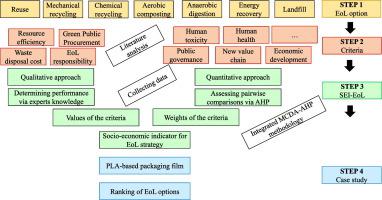当前位置:
X-MOL 学术
›
Ecol. Econ.
›
论文详情
Our official English website, www.x-mol.net, welcomes your
feedback! (Note: you will need to create a separate account there.)
A Socio-economic Indicator for EoL Strategies for Bio-based Products
Ecological Economics ( IF 6.6 ) Pub Date : 2020-08-21 , DOI: 10.1016/j.ecolecon.2020.106794 Idiano D'Adamo , Pasquale Marcello Falcone , Enrica Imbert , Piergiuseppe Morone
Ecological Economics ( IF 6.6 ) Pub Date : 2020-08-21 , DOI: 10.1016/j.ecolecon.2020.106794 Idiano D'Adamo , Pasquale Marcello Falcone , Enrica Imbert , Piergiuseppe Morone

|
In recent years, the bioeconomy has received increased attention from policy makers and practitioners, leading to a first switch from fossil to bio-based products. To open up new market opportunities, transparent information on the sustainability of bio-based products must be provided, taking into account all life cycle stages. The determination of suitable end of life (EoL) strategies furthers this aim. Notably, the socio-economic aspects of EoL alternatives associated with bio-based products have been neglected. This paper contributes to filling this gap by proposing a new socio-economic indicator for EoL (SEI-EoL). The SEI-EoL is developed from an integrated analytic hierarchy process–multicriteria decision analysis (AHP-MCDA) model based on experts' involvement, and is capable of measuring and comparing the socio-economic performance of EoL alternatives for bio-based products. The SEI-EoL is applied to the specific case of polylactic acid (PLA)–based film for food packaging. The results indicate that value chain actors are the most influential category of stakeholders in EoL management, and the assessment of criteria shows that waste disposal cost, resource efficiency and EoL responsibility play a key role in this management. The highest value EoL strategy for PLA-based film for food packaging is mechanical recycling, followed by chemical recycling. Circularity assessment, policy maker responsibility and incentives for recycled materials/green processes represent the most relevant items to consider for policy recommendations and actions.
中文翻译:

生物基产品停产策略的社会经济指标
近年来,生物经济越来越受到政策制定者和实践者的关注,导致首次从化石产品转向生物基产品。为了开辟新的市场机会,必须提供有关生物基产品可持续性的透明信息,并考虑到所有生命周期阶段。确定合适的寿命终止 (EoL) 策略可进一步推动这一目标。值得注意的是,与生物基产品相关的停产替代品的社会经济方面被忽视了。本文提出了一种新的 EoL 社会经济指标 (SEI-EoL),有助于填补这一空白。 SEI-EoL是在专家参与的基础上从综合层次分析法-多标准决策分析(AHP-MCDA)模型发展而来的,能够衡量和比较生物基产品EoL替代品的社会经济绩效。 SEI-EoL 适用于食品包装用聚乳酸 (PLA) 薄膜的具体情况。结果表明,价值链参与者是报废管理中最有影响力的利益相关者类别,标准评估表明废物处理成本、资源效率和报废责任在这种管理中发挥着关键作用。用于食品包装的 PLA 薄膜的最高价值 EoL 策略是机械回收,其次是化学回收。循环评估、政策制定者的责任和对回收材料/绿色工艺的激励措施是政策建议和行动中需要考虑的最相关的项目。
更新日期:2020-08-21
中文翻译:

生物基产品停产策略的社会经济指标
近年来,生物经济越来越受到政策制定者和实践者的关注,导致首次从化石产品转向生物基产品。为了开辟新的市场机会,必须提供有关生物基产品可持续性的透明信息,并考虑到所有生命周期阶段。确定合适的寿命终止 (EoL) 策略可进一步推动这一目标。值得注意的是,与生物基产品相关的停产替代品的社会经济方面被忽视了。本文提出了一种新的 EoL 社会经济指标 (SEI-EoL),有助于填补这一空白。 SEI-EoL是在专家参与的基础上从综合层次分析法-多标准决策分析(AHP-MCDA)模型发展而来的,能够衡量和比较生物基产品EoL替代品的社会经济绩效。 SEI-EoL 适用于食品包装用聚乳酸 (PLA) 薄膜的具体情况。结果表明,价值链参与者是报废管理中最有影响力的利益相关者类别,标准评估表明废物处理成本、资源效率和报废责任在这种管理中发挥着关键作用。用于食品包装的 PLA 薄膜的最高价值 EoL 策略是机械回收,其次是化学回收。循环评估、政策制定者的责任和对回收材料/绿色工艺的激励措施是政策建议和行动中需要考虑的最相关的项目。









































 京公网安备 11010802027423号
京公网安备 11010802027423号